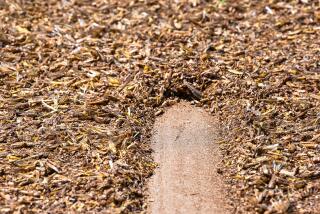ABC District Prepares to Pour More Money Into Turf War With Gophers
- Share via
What happens when a gopher chews Juicy Fruit gum?
A recent caller to the ABC Unified School District, which is gearing up to evict the pesky little rodents, suggested that instead of shelling out $26,800 for exterminators the district simply purchase some gum.
A gopher that chews the gum--and it has to be Juicy Fruit--is no longer a problem, according to the man offering the home remedy.
“Apparently the gum does something bad to the gopher’s stomach,” Virgil Hall said. Hall is assistant superintendent for business and personnel services for the 22,000-student district with headquarters in Cerritos.
“I’ve gotten more guff from this gopher situation than (questions) on the district’s $100-million budget,” Hall said during a telephone interview.
He was not chuckling. The gopher problem is doing bad things to his stomach.
For the second consecutive year the gophers are expected to do terrible things to the 306 acres that make up the school district and its 30 school sites in Artesia, Cerritos, Hawaiian Gardens and a small portion of Lakewood.
Officials said they are concerned mainly with students tripping over gopher holes and injuring themselves.
The gophers are more prevalent during the spring months, officials observed. They apparently breed underground in nearby freeway and park areas, then invade school campuses nearby, officials said.
“The gophers are prolific. They keep multiplying,” said Nada Piper, district executive secretary. Piper said her observations, while not scientific, came from being a long-time gopher-watcher in the district.
And gophers commute long distances.
“They like the groundcover near the freeways, which many of our schools are near. The joke around the district is (that) the gophers travel the freeways with the rest of the commuters,” Piper said.
Last week, in a race to get ahead of the unwanted underground tenants, the ABC Board of Education approved a $26,800 contract for a private pest control service.
That is when the home remedies started coming into the district. People want to save the district money.
“One woman (a beautician) suggested we take human hair, stuff it in a plastic bag and put it down the gopher holes,” Hall said. “The gophers would get a tummy-ache and leave.
“People have good intentions, but a remedy that works for them at home wouldn’t work for us. We have such a large area to cover.”
In past years the district had its own “grounds gopher man.” One employee, assisted by several others, was assigned full time to the gopher fight.
“We had at least six different people working on gophers. But our manpower couldn’t handle it. Last year the gopher problem seemed to reach its peak,” said Chit Bao, district director of maintenance, operations and transportation.
All of the schools had some gopher infestation, some more than others, Bao said. The schools near a freeway, such as Gahr High School in Cerritos, which is close to two freeways, had the most trouble. Schools near parks have similar problems, he said. The gopher squad, chemicals and equipment cost the district about $37,000, Bao said.
Near the conclusion of the 1987 “gopher season,” which ended around May, the district hired a private pest control company to try to eradicate the critters, Bao said. Bao said he believes the gophers not killed by the pest service merely moved to other areas.
Pat Bauer, a gardener and one of the district’s gopher eradicators, said it is not uncommon for the gophers “to become bait-shy.”
“They will eat some of the bait, get a tummy ache and move on to other grounds,” Bauer said.
This year, the pest company will start zapping the rodents before the beginning of the season, which is about Christmastime, Bao said.
The pest control company has the right stuff, ranging from the less potent bait to aluminum phosphide pellets, which are very potent, Bao said.
The pellets release an asphyxiating gas when inserted into the burrows. The holes are sealed. The chemical evaporates and there is no lingering gas to harm humans or pets, said Richard Wightman, a Los Angeles County agricultural inspector who coordinated a gopher attack in the city of Cerritos in 1987.
The baits are strictly controlled by the state Department of Food and Agriculture, Wightman said. Companies using the baits must be licensed by the state and must report the usage and amounts to the department.
While the gopher infestation is not unique to this area, Wightman said he never observed “any situation worse” than Cerritos’ problem.
Gophers normally stay beneath the ground during the day but “they were above ground at 9 a.m. They were picking them up in the streets,” Wightman said.
Last year, Cerritos spent $45,000 to bring its gopher infestation under control, city spokesman Michele Ogle said.
The gophers were coming from around the vacant 125-acre Towne Center site at 183rd Street and Bloomfield Avenue, which was being graded and weeded at the time.
‘Its under control and we spent only $3,000 this year in follow-up,” Ogle said.
The ABC district hopes it will have the same kind of success, board member Peggy Lee said. “We hope to wipe them out once and for all,” she said.
Aside from a bunch of gopher holes being aesthetically displeasing, the district’s main concern is the safety of students, Lee said.
“We don’t want a kid to step in a hole and twist an ankle,” Lee said. “The football season is coming up and we don’t want players being injured (stepping in gopher holes).
“Heaven forbid! We definitely don’t want a kid bitten by a gopher.”
There have been no serious gopher-related injuries reported to the district, Hall said.
More to Read
Sign up for Essential California
The most important California stories and recommendations in your inbox every morning.
You may occasionally receive promotional content from the Los Angeles Times.













